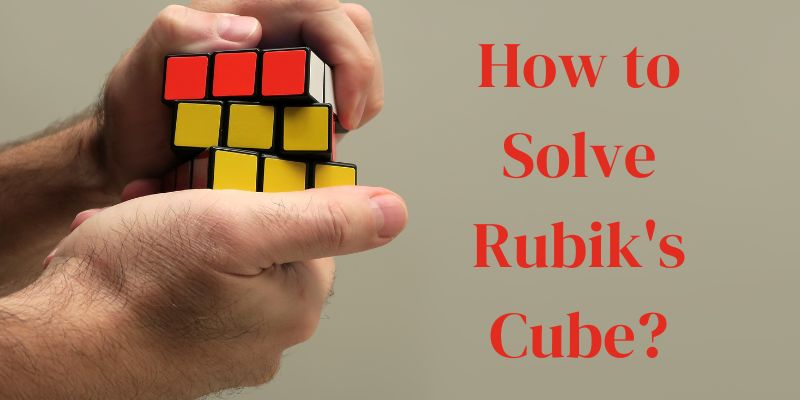Rubik’s Cube, a colorful, mind-boggling 3D puzzle, has captivated the hearts and minds of millions around the world since its invention in 1974. Its complex combination of colors and twisting, turning mechanics can seem intimidating at first, but fear not! In this comprehensive guide, we will demystify the secrets of the Rubik’s Cube and teach you how to solve Rubik’s Cube step by step. Whether you are a beginner or an aspiring speedcuber, we have covered you.
Understand the Basics
Before we dive into solving the Rubik’s Cube, let’s familiarize ourselves with the basics. A standard Rubik’s Cube consists of six faces, each made up of nine smaller squares. These faces are color-coded, with white, yellow, blue, green, red, and orange being the standard colors. Your goal is to arrange all the squares on each face so that one solid color is displayed on each side.
Pieces
Centers – Chromatic Anchors: These steadfastly anchored pieces serve as both the compass and canvas of the puzzle. In the solved state, they radiate with a single color, guiding the arrangement of surrounding pieces. When the cube is in disarray, these centers signify the destination of their corresponding color’s pieces, awaiting the symphony of reassembly.
Corners – Colorful Triads: Sprouting from the cube’s corners like vibrant blooms, these triadic wonders showcase a kaleidoscope of hues. A Rubik’s Cube boasts 8 of these captivating corners, each a harmonious trio of colors, challenging solvers to orchestrate their reunion amidst the twisting chaos.
Edges – Bridging Duets: Seamlessly connecting the corners, the edges embody duality, donning a partnership of two distinct colors. In total, 12 of these bridge-building pieces intertwine the corner’s colorful triads as they navigate the labyrinth of twists and turns.
Notation
To communicate the cube’s moves efficiently, we use a notation system. The six faces are labeled U (up), D (down), F (front), B (back), L (left), and R (right). A single letter represents a 90-degree clockwise turn of that face, and adding an apostrophe (‘) after the letter indicates a 90-degree counterclockwise turn. A 180-degree turn is denoted by adding the number 2 after the letter.
How to Solve Rubik’s Cube?
Beginner’s Method
The Beginner’s Method is the ideal starting point for anyone new to Rubik’s Cube solving. It involves a systematic approach to solving one layer at a time. Here are the steps:
Step 1: The Cross
- Start by choosing a color as your base color.
- Solve the cross on the first layer with the edges matching the center color.
- This step is all about matching edges and centerpieces.
Step 2: First Two Layers (F2L)
- Solve the first two layers simultaneously, pairing corner and edge pieces.
- Focus on intuitive pairing and placement.
Step 3: Orienting the Last Layer (OLL)
- Orient the last layer’s corner and edge pieces to the correct position.
- Memorize and execute specific algorithms.
Step 4: Permuting the Last Layer (PLL)
- Permute the last layer’s corner and edge pieces.
- Memorize and execute specific algorithms.
CFOP Method
The CFOP (Cross, F2L, OLL, PLL) method is an advanced approach that can help you solve the Rubik’s Cube even faster. Here’s how it works:
Step 1: Cross
- Begin by solving the cross on the first layer, just like in the Beginner’s Method.
Step 2: F2L
- Solve the first two layers using more advanced techniques.
Step 3: OLL
- Orient the last layer’s pieces using a set of algorithms.
Step 4: PLL
- Permute the last layer’s pieces with another set of algorithms.
This method is favored by speedcubers for its efficiency.
Roux Method
The Roux method is another advanced technique that can lead to speedy solves. Here’s a brief overview:
Step 1: First Two Blocks (F2B)
- Start by solving the first two 1x2x3 blocks.
Step 2: Last Six Edges (LSE)
- Solve the last six edges of the cube in two steps.
Step 3: CMLL and LSE
- Orient and permute the last layer of corners.
Step 4: Finish the Cube
- Complete the remaining steps, similar to other methods.
Petrus Method
The Petrus Method is known for its simplicity and efficiency. Here are the key steps
Step 1: Create a 2x2x2 Block
- Begin by forming a 2x2x2 block on one side of the cube.
Step 2: Expand to 2x2x3
- Extend the block to a 2x2x3 on one side of the cube.
Step 3: F2L
- Solve the first two layers intuitively.
Step 4: Finish the Cube
- Complete the cube using algorithms for the last layer.
Conclusion
Solving the Rubik’s Cube is a rewarding challenge that can be conquered by anyone with dedication and practice. Whether you are just starting or looking to improve your solving speed, the methods outlined in this guide – the Beginner’s Method, CFOP, Roux, and Petrus offer a variety of approaches to suit your level of expertise. So grab your cube, follow these steps, and let the colorful world of Rubik’s Cube solving unfold before your eyes. With persistence, you’ll soon become a master of this captivating puzzle!
You may also like:
20 Best Xbox One Games For Female Gamers
How To Play Paid Games For Free
12 Best Free Sports Streaming Sites
FAQs
Q:- Is there a specific order to solving a Rubik’s Cube?
Ans:- Yes, there is a recommended order known as the beginner’s method. It involves solving the cube layer by layer, starting with the first layer (white cross and corners), moving to the second layer (non-yellow edges), and concluding with the last layer (yellow cross, corners, and edges).
Q:- What are algorithms in Rubik’s Cube solving?
Ans:- Algorithms are predefined sequences of moves designed to manipulate specific pieces on the Rubik’s Cube without disturbing the solved parts. They are essential tools for solving the cube efficiently and can be thought of as specialized techniques for solving particular patterns or scenarios.
Q:- How do I position white corner pieces on the Rubik’s Cube?
Ans:- To position a white corner piece correctly, first locate it in the top layer. Identify the non-white colors on the corner piece. Then, manipulate the cube’s top layer until the white corner is between the corresponding centers of the non-white colors. Finally, execute the algorithm R U R’ U’ repeatedly until the white corner is correctly solved, and repeat this process for all white corners.







